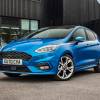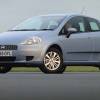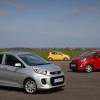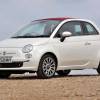
RAC sale – up to 33% off*
• Roadside cover from £5.29 a month†
• We get to most breakdowns in 60 mins or less
• Our patrols fix 4/5 breakdowns on the spot

By Jonathan Crouch
Introduction
In third generation form, Fiat's Panda aimed to be all the car some buyers would ever need. It's larger where it matters, yet still small enough for its urban purpose. It's pretty efficient, yet can offer surprising reserves of performance. And you can head off road in one - or specify a version that's super-affordable. The Italians have always done this kind of thing very well. They still do.
Models
5dr citycar (0.9, 1.2 petrol / 1.3 MultiJet diesel [Pop, Lounge, Mirror, 4x4, Cross, Cross 4x4])
History
What do you think has been the most influential - the most important - automotive design since the turn of the century? A sports car perhaps? Or an MPV or SUV? Certainly something expensive. We reckon not. Our personal pick would be this car: the humble Fiat Panda.
So what makes this model so extraordinary? Well let us explain it like this. Almost every car you can think of on the market can be pigeonholed into a specific market segment. And even if it can't be, it's likely to appeal to a very specific group of customers. The Panda's different. Though sized and priced as a little city car, it's so versatile and class-less that it can really function as. well, almost anything you want. Depending on the flavour you choose, it's a design as suited to city living as it is to the needs of a mountaintop farmer. It can be an SUV - or eco-conscious transport for Friends of the Earth. It can be a second vehicle for older empty-nesters. Or the sole car for a rural family. Less a citycar. More an 'essential' car, it is, in the words of one top Fiat executive 'the official car for doing whatever the hell you like'.
This is the Italian brand at its very best. The MK1 version was launched in 1980, the MK2 design dates back to 2003 and the MK3 version we're going to look at here was launched in 2011. An aggressive looking version of the top 4x4 variant, the Panda Cross 4x4, was launched in 2014 and the looks of that derivative were so well received that Fiat launched a much cheaper 2WD Panda Cross model with the base 1.2-litre engine in 2017. This MK3 Panda was updated in 2020 with mild hybrid power. But it's the MK3 2011-2019 models we're going to look at here.
What You Get
There's was something of a feeling of tiny MPV about the previous pre-2011-era MK2 generation version of this car. There still is in this MK3 form. It remains a tall car, with a vertical tail, a five-door-only shape and a large glass area, bigger than before (slightly longer, wider and taller) but sat upon the same wheelbase, so the roadway footprint remains basically unaltered. As for the friendly look, it's based upon what Fiat's designers call 'a squarical' theme, rounded rectangles in vogue everywhere from the headlamps to the front air intake, from the wheel arches to that trademark extra third rearward side window.
The squarical touches continue on inside. You'll find them in the instrument binnacle, on the steering wheel boss, the ventilation controls on the centre console - even on the seats where embossed rounded squares are there to better help air circulate between your body and the backrest. The dashboard itself is enveloped in a colourful frame with a roomy storage pocket in front of the front passenger supposed to evoke a nod towards original Eighties Panda motoring. That really was basic, though for its time, the MK1 model was undeniably clever, with seats that could be removed completely and washed. Or kept in and turned into a double bed.
We can't imagine anyone in a position to afford a modern Panda needing overnight in-car accommodation, but comfort will be a priority once seated at the wheel. Where you perch high-up in the kind of position you'd expect a miniature People Carrier to provide, complete with brilliant all-round visibility that makes even this slightly larger MK3 model easy to place in the tightest city streets. There are a few issues. We could do without a set of head rests finished in hard, unyielding plastic. And, as with many citycars, the steering adjusts only for height, not for reach, a particular issue in budget variants that don't offer a height-adjustable driver's seat. But on the plus side, the high-mounted gear lever is nicely positioned, the switchgear and stalk controls function with a quality click and the mouse-shaped handbrake lever is a lovely tactile touch.
Overall then, a cabin of much higher quality than before - far nicer indeed, than you'd expect a car of this class and price to provide. Unlike Fiat 500s, Pandas aren't built in Poland, the Tychy factory that assembled the old MK2 model abandoned for this MK3 in favour of a state-of-the-art Italian plant near Naples that seemed to screw the car together very well, something you can admire as you scratch around to find no fewer than fourteen different storage compartments that are apparently dotted around the cabin.
Storage for bigger items is taken care of by a 225-litre boot that's significantly bigger than that of the MK2 design, though still a little smaller than you'd find in a Volkswagen up! or its SEAT or Skoda clones. Or at least it is unless you get a car whose original owner ordered this Fiat with a clever touch none of its main rivals from this era can match - a rear passenger seat that slides by up to 16cm and enables you to prioritise room for either people or packages. If you've find a car fitted with this option, then with the rear seat slid right forward, luggage room increases to a class-leading 260-litres. Plus there's a bit more under the floor if you haven't got a car whose original owner paid extra for a spare wheel. If that's not enough, you can of course push forward the rear bench (it's only split-folding if you get a car fitted with the sliding seat or a plusher trim level) and free up 870-litres of total space, 36-metres more than the previous MK2 generation version could offer. With the rear seats flat, you've 2m of loading length, but if that's still not enough, you could seek out a car whose original owner paid extra for the fold-flat front passenger seat that potentially will enable you to carry really long items.
As for rear seat passenger space, well thanks to slim seats, it's perfectly adequate for a couple of fully-sized adults. With the optional fold-flat front passenger seat pushed forward, one of them could even stretch out chaise-longue-style if there was no one alongside the driver up-front. Bear in mind that original buyers had to pay extra for a three-person rear bench, so a third centre-point rear belt isn't a given here. Yes we know you'd never carry five adults in a car this small unless you were really desperate but you've three children to regularly transport, that capability is a really important feature to have. It's yet another thing that makes it conceivable for families to own this Fiat as an only car if need be, something just not possible with many of its rivals.
What You Pay
Please fill in the form here for an exact up-to-date information.
What to Look For
The Panda has earned a decent reliability record, helped in no small part by its reliable engines. Many will have been used as driving school cars, so check for slipping clutches. We've come across other issues with trim rattles (the driver's door handle has been known to easily break) and problems with the heating and ventilation system. Check for upholstery damage caused by child seats in the back, typical supermarket dents and scrapes, DPF filters on the diesel cars and ensure all the electrical functions work as advertised as these can be expensive to fix.
The Panda isn't bad on consumables like brake pads and discs, and most people should be able to park it without nerfing the extremities. The Dualogic auto gearbox can be temperamental. A full service history is desirable as city cars can get abused, while ensure the battery is still up to starting the car.
Replacement Parts
[based on Panda 1.2-litre petrol - 2016] Using the base 1.2-litre petrol model as an example, expect to pay around £4-£9 for an oil filter, around £6-£11 for an air filter and around £11-£14 for a wiper blade. Front brake pads vary in price between £18-£47 for a set; for front brake discs, think around £26-£50. A radiator costs in the £152 bracket. A headlamp costs in the £116 bracket. A water pump is in the £31-£51 bracket; a thermostat is around £20-£50; a starter motor is around £55.
On the Road
Most MK3 Pandas you'll come across will be fitted with the brand's 69bhp 1.2-litre 8v petrol unit. This may be an older engine but it's still a willing and free-revving one with performance (0-60mph in 14.2s on the way to 102mph) that'll be quite sufficient for most buyers. But shouldn't a car that thinks outside the box have an engine designed to do just the same? Fiat thinks so. Which is why the version of this car we'd recommend is the innovative petrol TwinAir variant. This has an engine with just two cylinders, to our mind, the kind of thing likely to generate about as much power as the average sit-on lawnmower. Yet in this turbocharged version, there are eighty five braked horses on tap, sufficient if you rev the thing pretty hard, to see sixty blow by in around eleven seconds on the way to an academic maximum of 110mph, thanks to 145Nm of torque.
That's pulling power you really appreciate in the nip and tuck of city traffic, peak torque arriving low in the rev range courtesy of clever TwinAir technology that allows the engine to breathe more easily. The result is that you'll find yourself palming the high-mounted gearlever around less often than you might expect. There's even an engine note to suit the cheeky compact looks, a putter-putter sound that seems to be exactly the kind of thing perfect for nipping through the back streets of Naples, the city where this model was made. If you are urban-bound and especially keen on cutting costs, there's the option of pushing a provided 'Eco' button on the dash which cuts your pulling power by nearly 50% to just 100Nm - which can be a be disconcerting if you forget it's on then suddenly need to dive for a gap in the traffic. A better option for Townies would be find a Panda fitted with the optional Dualogic gearbox, a kind of manual transmission without a clutch.
Fiat also made a 75bhp 1.3-litre Multijet 16v diesel variant, which on paper matches the TwinAir's frugality but in day-to-day reality, probably betters it. And with 190Nm of torque, it feels faster through the gears than the performance figures (sixty in 12.8s on the way to 104mph) might suggest. This diesel unit tends to feature on the Panda 4x4 models, though these can also be found with the TwinAir petrol unit too. They're remarkably capable off road, provided you don't expect too much.
Aside from engines and performance, there's plenty else for Panda people to appreciate in this third generation design. For a start, there's quite a 'big car' feel to the way that it drives, thanks to carefully tuned suspension, plenty of torsional stiffness and a wide track. The result is that it turns into corners quite sharply, rounding them with far less bodyroll than you might expect, an experience aided by decent sensitivity from the electric power steering. It's not too noisy on major routes at cruising speeds too - in fact, Fiat says that cabin noise was halved over the old MK2 model so that occupants could have a proper conversation while cruising at the legal limit. And that's something that makes you far more likely to want to take on a longer journey.
As for the rest, well as before, many of the underpinnings are shared with those of Fiat's other, more fashion-conscious citycar offering, the 500 - which is no bad thing as that car is a pretty fun steer, especially in an urban environment. Somewhere this Panda is just as at home. True, the five-speed gearbox could be a little more precise, but you'll appreciate the way this car takes even the nastier small urban bumps in its stride. And delivers neat little touches like the steering's 'City' mode option to increase the assistance it gives at parking speeds so that you can use the tight 9.3m turning circle more easily. Urban-friendly through and through you see.
Overall
Loved by small car people the world over for more than thirty years, the Panda continues to define everything that a very compact multi-purpose model should be. It's had to evolve of course, with more efficient engines and clever technology. But its heart remains simple, functional and innovative. Which is why, while other citycars will please only citycar folk, you could imagine this one being bought by. well, just about anyone.
A few other rivals may be a little cheaper, more refined or slightly trendier but few push the boundaries of design quite like this Fiat. It happily challenges just about every tiny car perception in the book. That you can't get really impressive fuel and CO2 figures without forking out loads of money for a diesel. That you can't seat five in this class of car. Or carry really large items. Or get big car hi-tech features. Panda people think differently thanks to a car that lets them do just that. It's got tough competition on the used market these days, no question. But in a growing segment full of talented offerings, it's a key contender you just can't help liking.







